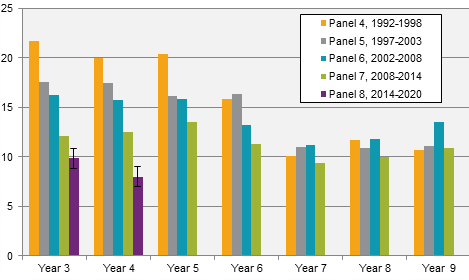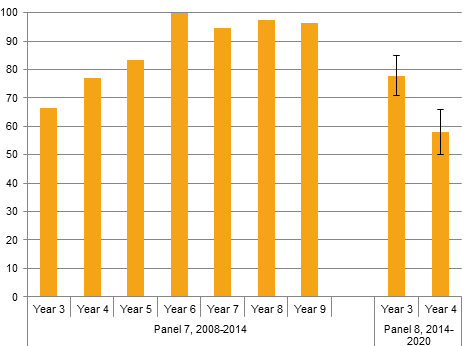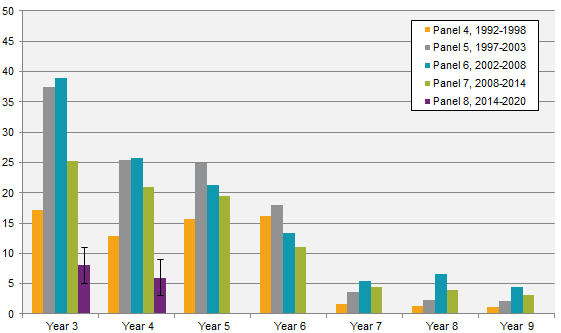Panel of students for longitudinal studies, school year 2014/15:
Percentage of pupils participating in remedial education in years 3–6 decreases
Statistical news from Statistics Sweden 2015-12-01 9.30
The percentage of pupils participating in remedial education in year 3–6 has decreased over time. In the spring of 2015, 1 out of 10 pupils in year 4 of compulsory education took part in remedial education. In the spring of 1992, 2 out of 10 in year 4 participated in remedial education.
In the "Panel of students for longitudinal studies" survey, a sample of 10 percent of the pupils in year 3 of compulsory school is followed through years 3–9. In the spring of 2015, the panel surveyed was panel 8 and the majority of the pupils were in year 4.
There has been a decrease in the percentage of pupils participating in remedial education in year 3–6 over time. Since the early 1990s the percentage in years 3 and 4 has been halved. In year 7–9, the percentage of pupils taking part in remedial education has remained more stable.

About 40 percent of the pupils participating in remedial education in year 3 of 2014 also took part in remedial education in year 4. Among the pupils participating in remedial education in year 4, half of them had taken part in remedial education in year 3 and the other half first participated in year 4.
6 out of 10 pupils taking part in remedial education in year 4 had action plans
Among the pupils taking part in remedial education in year 4 of 2015, about 60 percent had an action plan to assist the pupil in reaching the educational goals. When the pupils were in year 3 of 2014, the corresponding percentage was 80 percent. Furthermore, in year 4 of 2009, in panel 7, 80 percent of the pupils who participated in remedial education had an action plan.
About half of the pupils who had an action plan1 in year 3 of 2014 also had an action plan in year 4. Among the pupils having action plans in year 4, about 75 percent also had it in year 3. Only 25 percent had action plans for the first time in year 4.
1) An action plan is a tool to promote opportunities for pupils to reach their goals. The action plan should provide an overall picture of the school situation of the pupil. It should describe what should be handled on the individual, group and organisational levels.

More boys than girls take part in remedial education
In year 4 of 2015, it was more common among boys than among girls to have an action plan and to take part in remedial education. About 10 percent of the boys and 5 percent of the girls participated in remedial education. The difference between girls and boys is most evident among Swedish born pupils.
When it comes to having an action plan, the difference between girls and boys is more apparent among pupils in municipal schools than among pupils in independent schools. This was also the case when the pupils were in year 3.
In year 4 of 2015, the percentages of pupils participating in remedial education and of those having action plans were smaller among pupils where both parents have post-secondary education. This is most evident among pupils having action plans. Of those, 5 percent of the pupils with both parents having post-secondary education had action plans, compared to 10 percent of those with one parent with post-secondary education and 15 percent of those with none of the parents having post-secondary education.
The percentage of pupils in mixed level groups have de-creased in year 3–6
There has been a decrease in the percentage of pupils in mixed level groups in year 3–6 over time. In the spring of 1998 and 2003, about 25 percent of the pupils in year 4 were in mixed level groups, compared to 5 percent in the spring of 2015.

Half of the foreign born pupils have participated in home lan-guage classes in year 4
Among the pupils in year 3 of 2014, about 10 percent were foreign born. In year 4 of 2015, about half of those pupils participated in home language classes and roughly the same percentage participated in classes in "Swedish as second language". To take part in classes in "Swedish as second language” was more common among pupils with none of the parents having post-secondary education.
Among the pupils who participated in classes in "Swedish as second language” about 2 out of 10 also had action programmes. Among the pupils who did not participate in classes in "Swedish as second language” about 1 out of 10 had action programmes.
Definitions and explanations
The "Pupil panels for longitudinal studies" survey has been conducted since the early 1980s. A sample of 10 percent of the pupils in year 3 of compulsory school is followed through year 3–9. Most of the pupils were born 10 years before the first follow-up occasion. Comparable surveys have been conducted for pupils who were mainly born in 1967, 1972, 1977, 1982, 1987, 1992, 1998 and 2004. Follow-up surveys are conducted each spring and data are collected from the schools the pupils then are at.
In the spring of 2015, the panel surveyed was panel 8. Panel 8 consists of a sample of 9 800 pupils who were in year 3 in school year 2013/14. Since it is a sample survey, the estimations are marred by a sampling error. In the spring of 2015 the response rate was 73 percent.
Since the samples are drawn in year 3 pupils who moved to Sweden after year 3 are not included. Neither are pupils who sometime during grades 3–9 were enrolled in the compulsory school for pupils with learning disabilities.
Statistical Database
More information is available in the Statistical Database
Feel free to use the facts from this statistical news but remember to state Source: Statistics Sweden.
